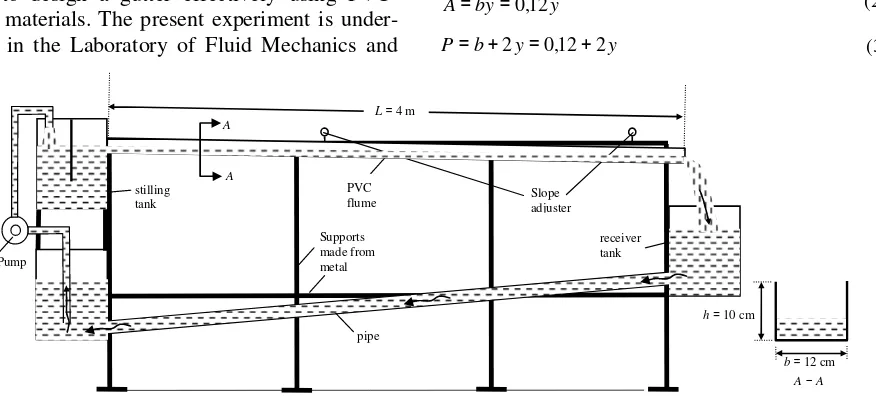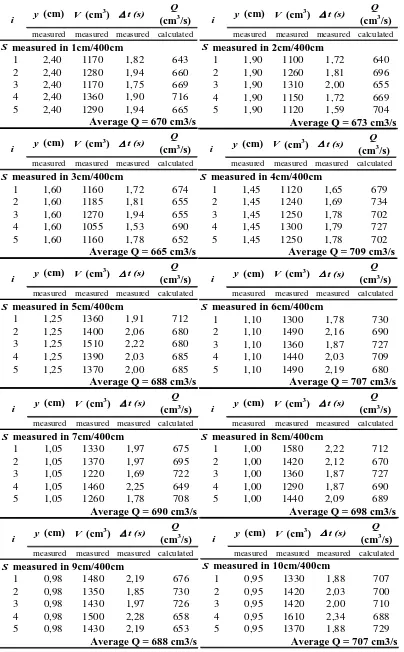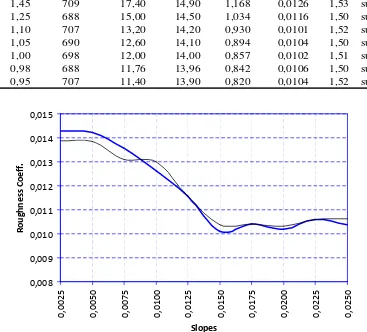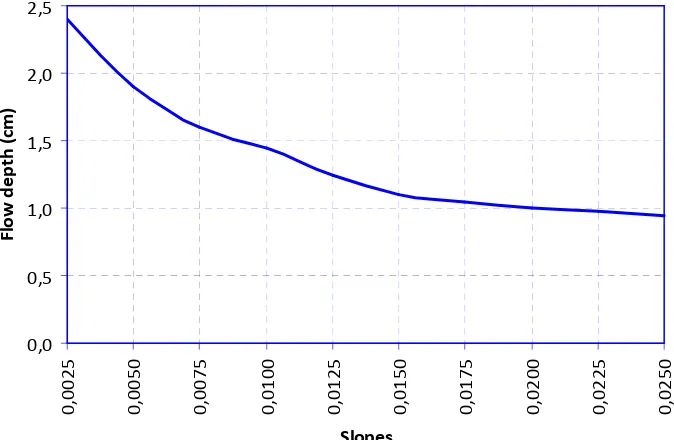Technical Notes:
Determination of Manning Roughness Coefficient for PVC Gutters
Mas Mera
Fluid Mechanic and Hydraulic Laboratory, Civil Engineering, University of Andalas Kampus Limau Manis, Padang, E-mail: [email protected]
Rizki Robi
Fluid Mechanic and Hydraulic Laboratory, Civil Engineering, University of Andalas Kampus Limau Manis, Padang, E-mail: [email protected]
Jurnal Teoretis dan Terapan Bidang Rekayasa Sipil Jurnal Teoretis dan Terapan Bidang Rekayasa Sipil
Abstract
This study is about the determination of the Manning roughness coefficient for a PVC (Polyvinyl Chloride) gutter and of its capacity due to longitudinal-slope changes. Both the roughness coefficient and gutter slope are factors that greatly affect both the velocity and depth of flow in a channel. For this purpose, an experiment is performed in
the laboratory using a PVC gutter with adjustable slopes. The Manning formula, i.e. a function of: flow rate; chan-nel roughness coefficient; flow depth (wet cross-sectional geometries); and channel longitudinal-slope, is then used. Water is supplied by a pump, and the discharge flow rate is determined by collecting the water that comes out at the end of the gutter downstream using a bucket. Then, both the volume of water in the bucket and the time it taking are measured. The flow depths are measured with a ruler (the other geometry sizes of the gutter are fixed, the length of 4m, width 12cm, height 10cm). These measurements were performed five times for each slope variation with 1cm/4m step (from 1cm/4m to 10cm/4m). The results show that the values of the Manning roughness coefficient for the PVC gutter range from 0.010 to 0.014. Due to an increase in the slope of 1cm/4m to 10cm/4m, the flow depth drops 60% to 40% for the same discharge.
Keywords: Roughness coefficient, gutters, PVC, Manning, slope.
Abstrak
Penelitian ini adalah tentang penentuan koefisien kekasaran Manning talang PVC (Polyvinyl Chloride), dan penen-tuan kapasitas talang akibat perubahan kemiringan memanjang saluran. Koefisien kekasaran dan kemiringan memanjang dasar saluran merupakan dua faktor yang sangat berpengaruh terhadap kecepatan dan kedalaman aliran suatu saluran. Oleh karena itu, dilakukanlah percobaan di laboratorium menggunakan sebuah talang PVC yang kemiringannya dapat diatur. Rumus yang digunakan adalah rumus Manning yang merupakan fungsi dari kecepatan aliran, koefisien kekasaran saluran, kedalaman aliran (geometri penampang basah saluran), dan kemiringan memanjang saluran. Air dipasok oleh sebuah pompa, dan debit alirannya ditentukan dengan menam-pung air yang keluar di ujung hilir saluran dengan sebuah ember. Volume air ember dan lama waktu yang diper-lukan diukur. Kedalaman aliran diukur dengan mistar (ukuran lain geometri saluran adalah tetap, yaitu panjang 4m, lebar 12cm, tinggi 10cm). Pengukuran dilakukan lima kali untuk setiap perubahan kemiringan memanjang saluran dengan tahapan kemiringan 1cm/4m (dari 1cm/4m sampai 10cm/4m). Hasil percobaan menunjukkan nilai-nilai koefisien kekasaran Manning talang air PVC berkisar antara 0,010 sampai 0,014. Akibat peningkatan kemiringan dari 1cm/4m ke 10cm/4m, kedalaman aliran turun sampai 60% (tinggal 40%) untuk debit yang sama.
Kata-kata Kunci: Koefisien kekasaran, talang, PVC, Manning, kemiringan saluran.
1. Introduction
Chow (1973), Dingman (2009), Brater et al (1996), Mays (2001, 2011), and FSL (2013) reported lists of the values of the Manning rough-ness coefficient for channels made from various materials. However, the coefficients for some materials were not available in the lists. One of
with four different surfaces, i.e. plaster only, and three aggregate-attached plasters, i.e. aggregates with small, medium, and large sizes. The results were about 0.013, 0.019, 0.021 and 0.028 respec-tively for Manning roughness coefficients. Djajadi contributed at least one n value, i.e. for a plaster-lined channel, because the three others need to be specified in more detailed what kind of roughness they are. This is due to Djajadi was more con-cerned in composite roughness coefficients instead of the homogeneous ones. Additionally, previous studies regarding PVC-made channels were reported by Mays (2000, 2011), Sturm (2001) and Kay (2008), but these focused on pipes.
Probably, the channel roughness coefficients made from one of these materials of plastic, rubber, and glass are next to those made from PVC. Linsley and Franzini (1979) listed both plastic and rubber for 0.009, French (1986) listed glass for 0.009 to 0.013, Chanson (2004) listed both glass and plas-tic for 0.010. A special note is given to Gribbin
Manning formula, i.e. the flow rate and flow depth to predict the values of the Manning roughness coefficient for PVC gutters. Mays (2001) listed some Manning roughness coefficients for gutters, but none of them was specifically for a PVC gut-ter.
The values of the Manning roughness coefficient for PVC gutters are important things and can be used to design a gutter effectively using PVC-made materials. The present experiment is under-taken in the Laboratory of Fluid Mechanics and
Figure 1. Sketch of a PVC gutter with slope adjusters
Hydraulics, Civil Engineering, the University of Andalas. The gutter used is made from PVC with brand of ”Maspion”, type AW (white color). The flow discharge used is supplied by a pump which is continuously working along the experiment.
2. Formulation
As can be seen in Figure 1, this model uses a standard PVC gutter with dimensions of length L = 4 m, width b = 12 cm, height h = 10 cm. The gutter is supported by a metal-made frame, and the gutter slope along the flow direction is adjust-able to a need. On the end of the gutter upstream, a stilling tank is installed. Both the gutter and tank are sealed using silicone glue. Meanwhile on the end of the gutter downstream, the water falls freely into the receiver tank. The water is pumped into the stilling tank.
To determine the flow rate Q, the water coming out at the end of the downstream is collected using a bucket. Both the volume of water in the bucket V and the time required to fulfill the bucket Dt are measured. This is done five times for every single position slope S, written
The hydraulic radius R is then defined by the wet cross-section area A divided by the wet cross-section perimeter P, written
As referred by Dingman (2009), an Irish engineer Robert Manning in 1889 developed an empirical formula for the computation of uniform flow in an open channel which has now been modified into the well known form, that is
where Q is the flow rate obtained in Equation (1) in m3/s, n is the Manning roughness coefficient, A is the wet cross-sectional area in m2 obtained in Equation (2), R is the hydraulic radius in m as defined by Equation (4), and S is the longitudinal slope of the channel base in m/m.
All variables in Equation (5) are already known except the roughness coefficient n. As mentioned above, variables A, R dan S can be quantitatively measured. However, the n value has to be deter-mined by undertaking a laboratory work as did by Djajadi (2009). Therefore, this equation will be convenient if written as
If the flow is at the critical state, the velocity head is equal to half the hydraulic depth, written
The hydraulic depth D is defined as the ratio of the wet cross-section area A to the top width. In the case of a rectangular channel, the value of the top width is equal to that of base width b, so that, the value of the hydraulic depth is equal to that of the flow depth. Substitute Equation (2) and D = y into Equation (7), and then simplify giving
where yc is the water depth at the critical state of
flow. If the flow depth predicted by Equation (8), that is yc, is bigger than the measured flow depth,
that is y, the flow is then at the super-critical state, and otherwise is at the sub-critical state.
P slope of the gutter, the flow depth y, and both the volume of water in the bucket V and the time required Dt to determine the flow rate Q are measured five times. There are 10 variations of the slopes with a 1 cm / 400 cm step. All of them are done continuously, and the pump is also work-ing continuously without any disturbwork-ing. The measurement results for the water depths in the gutter, the volume of water in the bucket, and the time required, and also the resulting flow rates are shown in Table 1
The next step is to predict the Manning roughness coefficient n using the flow depths y and the flow rates Q in Table 1, and using Equations(2), (3), are varied. The values of the roughness coefficient tend to increase when the slopes are mild. However, when the slopes over 5 cm / 400 cm (or 0,0125 cm/cm), the roughness coefficients tend to stable at the range of 0.010 to 0.011. In the view of the state of flow, the roughness coefficients are more stable at the super-critical state instead of at the sub-critical one.
The flow rates are measured five times in every slope stage. The gutter slopes are varied into 10 stages, so that there are 50 times of the flow rates measured. Due to all measurements are undertaken continuously, so that the average of all flow rates can be obtained by its arithmetic average, i.e.,
If the last average flow rate is used, the relation of the roughness coefficients and the slopes can be plotted as shown in Figure 2 (thin line), and the computation process is shown in Table 3.
y (cm) V (cm3) ∆∆∆∆t (s) Q (cm3/s)
measured measured measured calculated
S measured in 1cm/400cm
1 2,40 1170 1,82 643
Average Q = 670 cm3/s
y (cm) V (cm3) ∆∆∆∆t (s) Q
(cm3/s)
measured measured measured calculated
S measured in 2cm/400cm
1 1,90 1100 1,72 640
Average Q = 673 cm3/s
y (cm) V (cm3) ∆∆∆∆t (s) Q
(cm3/s)
measured measured measured calculated
S measured in 3cm/400cm
1 1,60 1160 1,72 674
Average Q = 665 cm3/s
y (cm) V (cm3) ∆∆∆∆t (s) Q
(cm3/s)
measured measured measured calculated
S measured in 4cm/400cm
1 1,45 1120 1,65 679
Average Q = 709 cm3/s
y (cm) V (cm3) ∆∆∆∆t (s) Q
(cm3/s)
measured measured measured calculated
S measured in 5cm/400cm
1 1,25 1360 1,91 712
Average Q = 688 cm3/s
y (cm) V (cm3) ∆∆∆∆t (s) Q
(cm3/s)
measured measured measured calculated
S measured in 6cm/400cm
1 1,10 1300 1,78 730
Average Q = 707 cm3/s
y (cm) V (cm3) ∆∆∆∆t (s) Q
(cm3/s)
measured measured measured calculated
S measured in 7cm/400cm
1 1,05 1330 1,97 675
2 1,05 1370 1,97 695
3 1,05 1220 1,69 722
4 1,05 1460 2,25 649
5 1,05 1260 1,78 708
Average Q = 690 cm3/s
i y (cm) V (cm
3
) ∆∆∆∆t (s) Q
(cm3/s)
measured measured measured calculated
S measured in 8cm/400cm
1 1,00 1580 2,22 712
Average Q = 698 cm3/s
y (cm) V (cm3) ∆∆∆∆t (s) Q
(cm3/s)
measured measured measured calculated
S measured in 9cm/400cm
1 0,98 1480 2,19 676
Average Q = 688 cm3/s
y (cm) V (cm3) ∆∆∆∆t (s) Q
(cm3/s)
measured measured measured calculated
S measured in 10cm/400cm
1 0,95 1330 1,88 707
Average Q = 707 cm3/s
b = 12 cm
S y Q A P R n yc State of
(cm/cm) (cm) (cm3/s) (cm2) (cm) (cm) (cm) Flow
0,0025 2,40 670 28,80 16,80 1,714 0,0143 1,47 sub-critical
0,0050 1,90 673 22,80 15,80 1,443 0,0142 1,47 sub-critical
0,0075 1,60 665 19,20 15,20 1,263 0,0136 1,46 sub-critical
0,0100 1,45 709 17,40 14,90 1,168 0,0126 1,53 super-critical
0,0125 1,25 688 15,00 14,50 1,034 0,0116 1,50 super-critical
0,0150 1,10 707 13,20 14,20 0,930 0,0101 1,52 super-critical
0,0175 1,05 690 12,60 14,10 0,894 0,0104 1,50 super-critical
0,0200 1,00 698 12,00 14,00 0,857 0,0102 1,51 super-critical
0,0225 0,98 688 11,76 13,96 0,842 0,0106 1,50 super-critical
0,0250 0,95 707 11,40 13,90 0,820 0,0104 1,52 super-critical
Table 2. Prediction of the Manning roughness coefficient n
0,008
Figure 2. The relation of the base slope and the roughness coefficients of the gutter
b = 12 cm Q = 689,5 cm3/s yc = 1,5 m
S y A P R n State of
(cm/cm) (cm) (cm2) (cm) (cm) Flow
0,0025 2,40 28,80 16,80 1,714 0,0139 sub-critical 0,0050 1,90 22,80 15,80 1,443 0,0139 sub-critical 0,0075 1,60 19,20 15,20 1,263 0,0131 sub-critical 0,0100 1,45 17,40 14,90 1,168 0,0130 super-critical 0,0125 1,25 15,00 14,50 1,034 0,0115 super-critical 0,0150 1,10 13,20 14,20 0,930 0,0104 super-critical 0,0175 1,05 12,60 14,10 0,894 0,0104 super-critical 0,0200 1,00 12,00 14,00 0,857 0,0103 super-critical 0,0225 0,98 11,76 13,96 0,842 0,0106 super-critical 0,0250 0,95 11,40 13,90 0,820 0,0106 super-critical
The use of the total average flow rate also has the same trend as that of partial average flow. Their
discrepancies are at the mild slopes; the roughness
coefficients obtained using the total average flows are smaller than those obtained using the partial one. Overall, their discrepancies can be ignored. The values of the roughness coefficient for the PVC gutter ranging between 0.010 to 0.014. The use in the normal condition, the coefficient is probably 0,011, the base slope is over 0,0125, and the flow is at the super-critical condition. The pre-sent roughness coefficients for the PVC gutter are slightly higher than the roughness coefficient for the PVC pipe as reported by Gribbin (2007) with range of 0,007 to 0,011. This variation is probably caused by the Manning equation was not derived from fundamental fluid-mechanic principles, nor was established by rigorous statistical analysis (Dingman, 2009).
1. The values of the roughness coefficient for the Manning formula for PVC (Polyvinyl Chlo-ride) gutters are successfully determined with range of 0.010 to 0.014.
Figure 3. The gutter slope and flow depth relation
2. At the typical condition, the coefficient is probably 0.011 with the slope rate over 5 cm / 4 m. The optimal gutter slope is 6 cm / 4 m, in which the flow depth drops 52 %.
3. For gutters with poor maintenance cause the velocity slower, so the use of highest coeffi-cient is better, say 0.014.
7. Recommendations
In the present study, it only uses a single PVC gut-ter with a rectangular shape from a specific brand. For the next studies, it is recommended to use Hydraulics Engineering Problems, McGraw-Hill Book Co-USA, 313p.
Chanson, H., 2004, The Hydraulics of Open Channel Flow: An Itroduction, Second Edition, Elsevier-Great Britain, 634p.
Chow, V.T., 1973, Open-Channel Hydraulics, McGraw-Hill Book Co-Singapore.
Djajadi, R., 2009, Comparative Study of Eqivalent Manning Roughness Coefficient for Channel with Composite Roughness, Civil Engineering Dimension, Vol. 11(2), p113-118.
French, R.H., 1986, Open-Channel Hydraulics, McGraw-Hill Book Co-Singapore, 705p.
FSL, 2013, Manning’s n Values, Hydraulic Reference, http://www.fsl.orst.edu/ geowater/FX3/help/
FX3_Help.html#8_Hydraulic_Reference/ Mannings_n_Tables.htm
Gribbin, J.E., 2007, Introduction to Hydraulics and Hydrology with Applications for Storm-water Management, Thomson Delmar Learning, 528p.
Kay, M., 2008, Practical Hydraulics, Second Edition, Taylor and Francis, 266p.
Linsley, R.K., and Franzini, J.B. 1979, Water-Resources Engineering, Third Edition, McGraw-Hill Inc.
Manning, R., 1889, On The Flow of Water in Open Channels and Pipes, Transcations of the Institution of Civil Engineers of Ireland 20, p161-195.
Mays, L.W. (Ed), 2000, Water Distribution System Handbook, McGraw-Hill Co. Inc., 644p.
Mays, L.W., 2001, Stormwater Collection Systems Design Handbook, McGraw-Hill Co. Inc., 1017p.
Mays, L.W., 2011, Water Resources Engineering, Second Edition, John Wiley & Sons, Inc., 917p, ISBN 978 0 470 46064 1,



